SONY
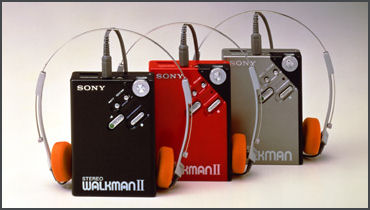
1981 Walkman II Sony is arguably Japan's best known company and one of the world's largest and most well respected consumer-product manufacturers. Its products are world famous and sold everywhere around the globe. Surveys in early 2000s have showed that Sony was the most recognized and esteemed brand name in the United States (ahead of Coca Cola, General Motors and General Electric) and is third coolest global brand after Nike and Tommy Hilfinger among American teens. Although Sony has some of its luster since then it is still a remarkable company.
Sony is the world’s No. 2 consumer electronic maker after Panasonic with around $70 billion in worldwide sales. One of Japan’s first internationally-minded companies, it has relied heavily on exports and was among the first Japanese firms to build a U.S. factory. In the 1960s, 70s and 80s it helped turned "Made in Japan" from a joke into a symbol in unsurpassed quality. Sony businesses run from digital cameras and personal computers to PlayStation game consoles and movies such as "Spiderman."
Sony has traditionally been known as a great innovator that transformed entire categories of electronics with products like the Walkman music player and PlayStation game console, and was able command premium prices for its top-quality products. Sony not only changed business and the electronic industry it also changed the world. Before it came along electronics were large bulky products that kept people sequestered in their homes. After Sony, they became small products that people they could to take with them to enhance their surroundings wherever they went.
Sony topped a Harris poll for best brands for the 7th consecutive year in 2006. Dell and Coca Cola were 2nd and 3rd respectively. In 2004, it was ranked by Forbes as the 72nd largest company in the world. Sony placed 35th in the 2011 Interbrand Best Global Brands ranking. Coca Cola and IBM were No. 1 and 2.
Sony had 168,200 employees as of 2011 and 57 manufacturing sites as of September 2008. It has traditionally been regarded as one of the top transnational companies in terms of foreign assets and foreign employees. The goal of the company has been to apply the most advanced technology to consumer products for fun and enjoyment rather than just practical uses.
Websites and Resources
Good Websites: Sony.com www.sony.com ; Wikipedia article on Sony Wikipedia ; Sony History sony.net/SonyInfo/CorporateInfo/History ; Akio Morita Library akiomorita.net ; Walkman History pocketcalculatorshow.com ;Sony Aibo Europe sony-europe.com/aibo ; Wikipedia article on Sony Robot Wikipedia ; Sony Computer Science Laboratory www.sonycsl.co.jp ; Book: “ Sony: Private Life” by John Nathan, a professor of Japanese Cultural Studies at the University of California, Santa Barbara (Houghton Mifflin, 1999). It is a very good book.
Sony Video and Computer Games Sony Computer Entertainment www.scei.co.jp ; Japan Video Games japanvideogames.com ; Wikipedia article on Sony Computer Entertainment Wikipedia ; Offical PlayStation site us.playstation.com ; Sony’s wii latimesblogs.latimes.com
Links in this Website: JAPANESE ELECTRONICS INDUSTRY Factsanddetails.com/Japan ; JAPANESE ELECTRONICS COMPANIES Factsanddetails.com/Japan ; CANON, SHARP AND TOSHIBA Factsanddetails.com/Japan ; SONY Factsanddetails.com/Japan ; SONY PRODUCTS Factsanddetails.com/Japan ; PANASONIC Factsanddetails.com/Japan ; INDUSTRIES IN JAPAN Factsanddetails.com/Japan ; JAPANESE COMPANIES Factsanddetails.com/Japan ; TRADE AND OVERSEAS BUSINESS IN JAPAN Factsanddetails.com/Japan ; TECHNOLOGY IN JAPAN Factsanddetails.com/Japan ; GADGETRY AND INVENTIONS IN JAPAN Factsanddetails.com/Japan ; COMMUNICATIONS IN JAPAN Factsanddetails.com/Japan ; CELL PHONES IN JAPAN Factsanddetails.com/Japan ; VIDEO GAMES IN JAPAN Factsanddetails.com/Japan ; SONY VIDEO GAMES Factsanddetails.com/Japan ; NINTENDO Factsanddetails.com/Japan
Good Websites and Sources on the Electronics Industry: Japanese Electronics and Information Technology Industries Association (JIETA) jeita.or.jp/english ; Google E-Book: The Japanese Electronics Industry books.google.com/books ; JETRO Report on Japanese Consumer Electronics jetro.org/content ; Nikkei Electronic Asia techon.nikkeibp.co.jp ; Gadgets and Consumer Electronics Blogs blogged.com/directory/shopping/consumer-electronics ; Companies Listed by Industry mizuho-sc.com ; Japan Shuffle, a blog with info on electronics japanshuffle.blogspot.com
Good Websites and Sources on Industry: Good Photos at Japan-Photo Archive japan-photo.de ; Companies Listed by Industry mizuho-sc.com ; Ministry of Economy, Trade and Industry meti.go.jp/english ; Statistical Handbook of Japan Manufacturing Chapter stat.go.jp/english/data/handbook ; 2010 Edition stat.go.jp/english/data/nenkan ; News stat.go.jp
Akio Morita
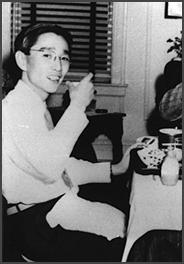
Morita Akio Morita (1921-1999) was the charismatic co-founder of Sony Corp. Selected by Time magazine as one of 20 "most influential business geniuses" in the 20th century, he was arguably the best known Japanese in his time. Recognizable by his long white hair, parted in the middle, he functioned as product visionary, business strategist and chief salesman for Sony. [Source: Time magazine]
Morita was born into a wealthy sake-brewing family in Nagoya. He had gray eyes, unusual for a Japanese, which led to rumors that maybe there was Russian blood in him. As a boy he was obsessed with gadgets and neglected his homework to build a crude phonograph and radio. He studied physics in college and did research in heat-seeking weapons with the Japanese navy during World War II.
Morita and his wife Yoshiko had three children. At home it was said he was a traditional Japanese husband and a strict disciplinarian with his children.
Book: “Made in Japan”, Morita's autobiography (E.P. Dutton, 1986).
Morita's Character
Morita was full of energy and charms. He lit up a room when he entered, went out of his way to greet new people and made everyone who met him feel they were a friend. He spoke in imperfect but passionate English about products and ideas and was able to get away with making controversial nationalist remarks in part because he came across as so affable.
Morita was regarded as a flamboyant showman. He appeared in commercials for American Express, skied, skydived and scuba dived when he was in his 60s, flew around the globe in private jets and helicopters and hung out with people like singer Cyndi Lauper, Washington Post chairman Katherine Graham, financier David Rockefeller, and conductor Leonard Bernstein.
Even so Morita was never completely comfortable in the Western business world. His son told Time, "He had to...act as the most international-understanding businessman...It was never real." Morita co-authored an American-bashing book called “The Japan That Can Say No” in which stated that Japanese would buy American products if they were good and that perhaps American executives would have more success if they didn't pay themselves so much.
Morita and Masura Ibuka
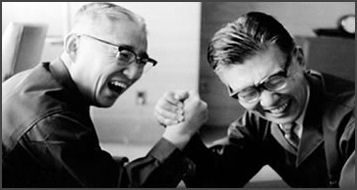
Morita and Ibuka From a young age Morita had been groomed to run the family sake business, which had been going for 14 generations. After the war Morita won a "temporary" reprieve from this obligation and went to Tokyo and met up his wartime buddy Masura Ibuka (1908-1997), who worked with Morita on the heat-seeking missiles.
In Japan, Ibuka is largely regarded as the true founder of Sony. He was the engineering genius behind many of its products and the an one who inspired the research teams while Morita is regarded as the marketing genius and internationalist that made Sony into it is.
Morita’s Business Career
Morita toured the United States, Germany and the Netherlands in 1953. He was inspired by the economic growth in the U.S. and Germany and felt that if the Dutch-company Phillips could succeed in the electronic business then so could his company.
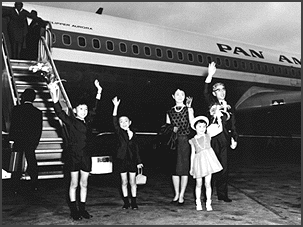
Morita arrives in U.S. with family Morita lived in New York for 15 months in the early 1960s with his family while he was setting up Sony Corporation of America, the first Japanese company to list its shares on Wall Street. America was the focal point of Morita’s master plan for Sony to rule the world.
Morita became the best connected Japanese businessman in the United States and served in the international advisory boards for Pan Am, IBM and Morgan Guaranty Trust and set up profitable joint ventures with CBS, Texas Instruments and Prudential Life Insurance.
Morita did not become Sony's official president until 1971 and its CEO until 1976. Before that he was Ibuka's junior partner.
Morita reached the peak of his career in 1993, at the age of 72, when he was picked to be the chairman of Keidanren. Tragically, on the same day the announcement was made, Morita suffered a serious stroke while playing tennis. He retired from Sony for health reasons in 1994. He spent much of his last years in Hawaii and died of pneumonia in 1999.
Early History of Sony
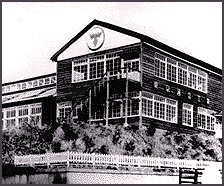
early factory Morita and Ibuka founded the Tokyo Telecommunications Engineering Corp. (the predecessor of Sony) in 1946 in a bombed out Tokyo department store building with an investment of less that $500. In the early years the company had 20 employees
The company began by producing components and kits that upgraded AM radios into short wave radios. Their first major product, a reel-to-reel tape recorder, was released in 1950. Other early products included electrically-heated seat cushions, electric megaphones and audio control consoles.
In 1951 the company had 159 employees and $439,500 in annual sales. In 1956 its had 483 employees and sales of $3.35 million.
In 1958, Tokyo Telecommunications Engineering Corp. abandoned its cumbersome name and adopted a new name, Sony, a playful combination of “ sonus” , the Latin word for "sound," and "sunny boy," English slang for a young innovative man. The Sony name was used on transistor radios before it became the name of the company.
Sony Transistor Radio
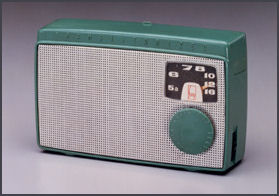
1955 radio The product that changed Sony was a jade-green transistor radio first sold in 1955. It utilized transistor technology developed by AT&T's Bell Laboratories in 1947 for phone switching equipment and hearing aids.
Sony licensed the rights to transistors in 1953 but didn't make the world's first transistor radio: an American company released one a few months earlier but it didn't sell. Sony's radio became a success from Morita determination. Staying in cheap hotels and eating at automats, he went around New York city, convincing electronics stores to carry the radios and convinced them of the potential of a small portable electronics.
The Bulova watch company placed an order for 100,000 radios under the understanding that they would be sold under the Bulova name. The order was worth more than the company's worth but Morita turned them down because he had dreams of making Sony an international brand. Morita later said it was the best business decision he ever made.
People bought the radios and the company came out with smaller and smaller varieties, including a pocket-size model in 1957 (which actually was too large for pocket so it was sold by Sony salesmen wearing clothes with enlarged pockets). These radios were the perfect product for the emerging rock n' roll generation that not only wanted to enjoy a new kind of music on the radio but wanted to take that music with them to where the action was.
Early Sony Televisions and the CD
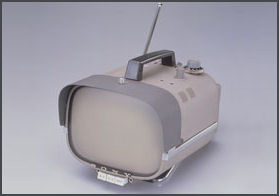
1960 TV In the 1960s Sony revolutionized television as it had done with radio. It developed the first transistorized television in 1959 (an expensive and unreliable device that didn't sell well) and the Triniton color TV system in 1968. Those products made televisions smaller and more affordable and changed the way people lived by moving televisions out of the living room into every room of the house.
Sony invested heavily in the Beta format for VCRs, which they introduced in 1975 but ultimately lost the rival VHS system backed by its main competitor Matsushita (Panasonic). Even so Sony helped bring video into people homes and Sony profited wonderfully from a revolution that allowed people to watch what they wanted when wanted to, without commercials if they so desired. It also brought pornography out of the red light districts into people's homes.
Sony also gave the world the camcorder in 1985. The Rodney King incident — the police beating captured on video during riots in Los Angeles in the early 1990s — is one example of what can happen when ordinary people are set lose with their own video cameras. Now look at the You Tube world.
Sony sold the world’s first CD in 1982. Five years later CDs overtook LP record sales in Japan. The specifications used in 1982 are still used today. Norio Ohga (1930-2011) — chairman of Sony from 1982 to 1995 — is credited with developing the CD . Recruited after he complained about the quality of Sony recordings, he helped develop the technology and insisted on CDs being 12 centimeters in diameter and hold 75 minutes worth of music — enough to store all of Beethoven’s Ninth Symphony. Once an aspiring opera singer himself, Ohga insisted in the 1970s that CDs would eventually replace vinyl records because of the superiority of digital sound. Early supporters of his work included Stevie Wonder and Herbie Hancock.
Sony Walkman
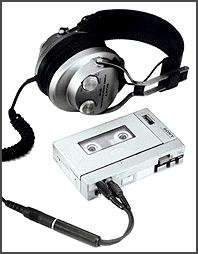
Walkman prototype The Walkman miniature cassette player first went on sale in July, 1979. Inspired by pocket cassette recorders designed for dictation, it changed the way we lived by making music and electronics portable, personal and mobile. It changed the lifestyles and listening habits of millions and was particularly embraced by young people, commuters and joggers. In 1986, "Walkman" was added to the Oxford English dictionary. For a while it was used as a generic term for all portable music devices.
The Walkman was originally made as a prototype so that Sony co-founder Akio Morita could listen to opera on long-distance flights. The device, which was original marketed in Britain as the Stowaway, almost didn’t happen. “Everybody gave me a hard time,” Morita said in his memoirs. Sony engineers and executive said it was ludicrous to sell a tape-player without a recording function. It took a while for the Walkman to catch on. Sales initially were sluggish.
The Walkman has been described as Morita’s product and his greatest contribution to Sony. It was Ibuka who came up with the idea for product but Morita was the one who overcame resistance of senior Sony executives to bring the product to market.
The Walkman was the right product for the right time. It was the prefect device for the me generation era and the fitness craze. Its headphone output jack was originally named "guy" and input hole "doll." A famous Walkman ad from the 1980s featured a monkey (a Japanese macaque) listening to a Walkman with a very human-like relaxed, content expression on its face.
The Walkman was followed by Watchman mini television (1982) and Discman compact disc player (1984) and hundred of imitations by competitors.
As of 2004, 340 million Walkman had been sold and130 different Walkman models had been released. They included models that ran MDs and memory sticks. The first device to gain as much attention as Sony’s Walkman was Apple Ipod, released in 2004. In response to that Sony introduced a hard disk Vaio pocket and a hard disk Walkman. In October 2010, Sony announced it was cease producing conventional Walkman cassette players. They were done in by competition from MP2 players and Ipods. They lasted for 31 years.
Sony Success
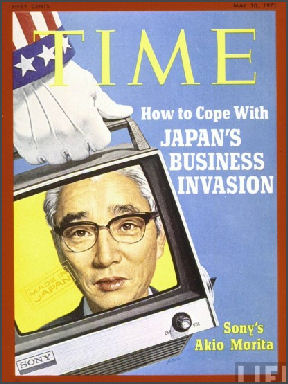
From the beginning Sony was determined not to produce discount products but rather high-priced, high-quality items. The first transistor radio sold from $29.98 at a time when television didn't cost much more and new cars sold for less than $1,000.
One reason that Sony found success in America first and made such a mark in the global market is they were shut of Japanese markets by Matsushita, which dominate the domestic Japanese electronics market and its distributors.
Sony took off in the 1970s and 1980s with the sales of sleek, modern-looking televisions, Walkmans, compact disc players, VCRs and other popular electronic devices. Sony as much as another company helped erase the notion that Japan made inferior products.
Sony's research laboratories employed 1,000 engineers whose goal was to make products people didn't know they needed. Morita once said, "Our plan is to lead the public with new products rather than ask them what kind of products they want." Among the things it came up was the CD which it invented with Phillips and launched in 1982.
In 1961, Sony had 3,703 employees and $51.6 million in sales. In 1966, it had 6,061 employees and $130.4 million in sales. In 1971, Sony had grown to 10,003 employees and $544.7 million in sales. By 1991, it was a global giant with 19,811 employees and $27.96 billion in sales. In 1999, Sony had worldwide sales of $57 billion and a profit of $1.2 billion.
Changes at Sony
Sony was headed in the 1990s by Chairman Norio Ohga, a tough, pragmatic business with a knack for making money, and President Nobuyuki Idei, an English- and French-speaking jazz lover and friend of Bill Gates. Idei played the Morita role. He was regarded as a conceptual, marketing man who logged thousand of miles a year, pitching Sony products and ideas.
By 1995, Sony had become a huge multinational operation with large research and production facilities in the United States. By that late 1990s more than half of its products were made outside of Japan and it exported $1 billion worth if U.S.-made goods. In the past decade China has became Sony’s main manufacturing center.
Sony has struggled as it has tried to transform itself from a consumer electronic maker to a multifaceted media and network giant. In recent years it has not produced many big hits, its path to the future is not clear and some say the company has strayed from what it does best. In 2001, for example, Sony opened a full-service consumer Internet bank and began operating an online service that would make it music, movies, games and televison available to people over the Internet for a price.
Sony has entered many alliances with its competitors. It established a $3.1 billion joint venture with Samsung in 2003 to make liquid crystal display for flat screen televisions, and it was working with NTT DoCoMo to produce wallet phones (cell phones with smart cards that could be used to buy things). It makes cell phones with Sweden’s Ericsson and formed an alliance with Toshiba and IBM to build the world’s fastest chips. Sony’s and Panasonic’s Blue-Ray next-generation laser discs defeated NEC’s and Toshiba’s HD-DVD discs in clash that was compared to the Betamax-VHS battle in the 1970s.
Sony has invested heavily in developing new semiconductors, displays and optical devises as part of a strategy to make key components for its digital cameras, personal computers, flat-panel televisions and other products made by other manufacturers as well as products sold under its name. It also began producing luxury, custom-made, accessories. As of early 2004, it had a 20 percent share in the global digital camera market and a 30 percent share of the flat-TV market. .
In December 2004, Sony announced it was going to quit the plasma-screen television market and instead concentrate on liquid-crystal display (LCD) televisions and rear projection television for which there is strong demand in the United States.
Sony, Movies and Video Games
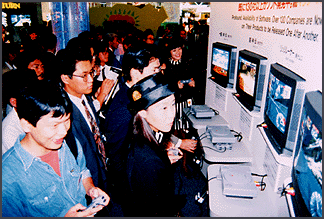
PlayStation deput in 1994 In the late 1980s Sony purchased Columbia Pictures for $3.4 billion. At first it seemed like a bad decision as it seemed the only thing the studio could put out was huge money-losing films.
In the late 1980s Sony also purchased Columbia Records Group for $2 billion. Later it bought MGM and merged with Bertelsmann music group. See Below
Sony was a late arrival in the video game business. The company brass regarded Sony as strictly an audiovisual company and regarded entrance into the "game and toy" market as embarrassing.
The success of Sony’s game consoles have been credited to Ken Kutaragi, a former engineer and the CEO of Sony Computer Entertainment and the “the father of the Playstation.” He was the one that convinced Sony to go into gaming alone after the deal with Nintendo fell through. He assembled a team that developed PlayStation from scratch in the 1990s. His team outdid itself with PlayStation II, which was made with components made from scratch (in the past consoles were made with off the shelf parts).
Sony PlayStation

PlayStation 2 PlayStation and its sequel Playstation2 were invented by a team led by Kutaragi. Sony's success was based in part on the wooing of independent games designers, who were tired of being manipulated by Nintendo. PlayStation sold well and games played on it sold well.
Sony PlayStation was launched in 1994. It was introduced to compete with Nintendo’s Super Famicon, which had debuted only weeks before. The irony os that Sony developed the game console after Nintendo pulled out of a joint venture.
In 1998 PlayStation1 earned Sony $5 billion and 40 percent of its profits. By 2000 in one in every four U.S. households had one. The 100 millionth PlayStation was shipped in May 2004. Of these about 70 million were PlayStation2s But by that time sales had slowed to a point that Sony’s net income was hurt.
See Playstation 2 and 3, See Sony Products
Chip Espionage
In the early 2000s, Sony, Toshiba and IBM collaborated to make a revolutionary computer chip — the superfast Cell chip — for Sony’s PlayStation 3. In his book on creating the chip “The Race for a New Game Machine”, IBM computer engineer David Shippy documented how IBM secretly provided Microsoft with the same chip for its Xbox 360 game.
Shippy said one of the hardest obstacles to overcome to in creating the Cell chip was heat. In his book he wrote: “game consoles are smaller than PCs and have less capacity to keep the chips cool, and games are very compute-intensive functions that tend to max out the processor usage. Higher power on the PlayStation 3 would lead to more costly thermal control techniques like fans and heat sinks...We had to invent a new animal that ran like cheetah, roared like a lion, and ate like a kitten.”
On handing the chip over to Microsoft, Shippy wrote: “Though three STI partners (Sony, Toshiba and IBM) previously agreed to the use of parts of the Cell chip in future derivative [products] and it certainly was within IBM’s right to do so it never occurred to anyone that this would happen before the Cell chip was completed and the PlayStation3 launched. So it wasn’t illegal, but it reeked of unsportsmanlike behavior...Keeping secrets from the Japanese engineers who had worked side by side with us for the last two years...didn’t feel right to any of us.”
Sony Workers
In many cases Sony has abandoned assembly line automation in favor of craft work. At some Sony plants workers assemble entire camcorders themselves on "spiral line" tables. The methods has proven to be 10 percent more productive than the conventional way of way making the cameras.
"The spiral performs better," wrote Michael Williams in the Wall Street Journal, "because it frees efficient assemblers to churn out more products instead of limiting them to a conveyor belt's speed. It reduces handling time, the seconds consumed as goods under production are passed from worker to worker. And if something goes wrong, only a small section of the plant is affected."
"There is no future in conventional conveyor lines," a Sony consultant told Williams. "They are a tool that conforms to the person with least ability." Many of Sony's assembly lines are run primarily by robots."
Sony Film and Television Programming
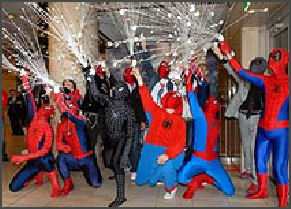
Spiderman 3 premier in Tokyo In the late 1980s Sony purchased Columbia Pictures for $3.4 billion. At first it seemed like a bad decision as it seemed the only thing the studio could put out was huge money-losing films.
In 1994, Columbia knocked $3 billion off Sony's profits. One its films, “ Last Action Hero” (1993) lost more money than any other film in history. It cost $124 million to make and grossed only $44 million for a loss of $80 million. Sony was also hurt by a string of other money-losing films and a $400 million contract payoff to Hollywood producers Jon Peters and Peter Gruber.
Late Columbia had successes with “ Spiderman, Men in Black, Stuart Little, Men in Black II, Stuart Little II, Crouching Tiger, Hidden Dragon”, and “Black Hawke Down”.
In September 2004, a group headed by Sony purchased MGM for $2.85 billion and took in $2 billion of the company’s debts. MGM had fallen on hard times. Iit was no longer producing many successful new releases but its library was regarded as very valuable in the booming DVD market. It also owns the rights to the James Bond films.
Sony posted a profit of ¥163.84 billion in fiscal 2004, up 85 percent from previous year due to the record operating profits of its movie division, which produced popular films like “Spiderman 2". In 2006 Sony had hit with “ Superdbad, Casino Royal, The Da Vinci Code” and “Spider Man 3".
In 2008 Sony began moving aggressively to expand its domestic and international television business, acquired top production companies and offering local-language content, making it the largest television producer not directly connected with a broadcast network.
Sony has shows on the air or in development for all the major US. network and several cable operators. It produces “ Jeopardy” and “Wheel of Fortune” as well as FX’s “Damages”, ABC’s “The Unusuals” and creates international versions of popular American comedies such as “Married with Children” in places like Russia.
Sony is working with YouTube to release full-length films on the Internet. It shows old films and classic television shows on its Crackle.com. Sony is also working with Google on a project to make hundreds of e-books available on The Internet
Sony Music
Sony Music is Japan’s largest record company. In the late 1980s Sony purchased Columbia Records Group for $2 billion. Like Columbia Pictures, its record was also spotty, and has included disputes with big stars like Bruce Springsteen, George Michael and Michael Jackson.
In 2002, Michael Jackson had a widely publicized legal battle with Sony. With Johnnie Cochran and the Rev. Al Sharpton acting as advisors, he called Sony music racist and called the head of Sony music the devil, drawing a picture of him with horns and a pitchfork, and blamed the company for not promoting his new album. The move was widely seen as an attempt by Jackson to win concessions from Sony, which co-owns Jackson’s valuable music catalogue, which includes his hit songs as well as many songs by the Beatles.
In the late 1990s, Sony tried to jazz up its image. A 1997 Sony Music Entertainment ad in a British rock magazine went: "Three essentials for a great holiday. Sex, drugs, and rock and roll. We'll provide the rock and roll. You take care of the rest."
In 2004, Sony and BMG (Bertelsmann) merged to create the world’s second largest music company after Vivendi Universal Music.The new company was called Sony-BMG. The new company had $4.5 billion to $5 billion in annual sales and embraces artists like Aerosmith, Beyonce and Britney Spears.
In August 2008,Sony agreed to buy Bertelsmann’s entire 50 percent stake in Sony BMG music for $900 million and took full control in October 2008. The decision ended the four-year Sony-Bertelsmann music partnership that was characterized by the New York Times as “more dissonance than harmony.”
Share of U.S. music album sales: 1) Vivendi Universal Music (32 percent); 2) Sony and BMG (25 percent, with Sony 15 percent and BMG 10 percent); 3) Warner Brothers (21 percent); 4) EMI Music (9 percent); and Independents (14 percent).
Sony Artists include Jennifer Lopez, the Dixie Chicks, The Offspring. BMG artists include Avril Lavigne, OutKast, Usher, Foo Fighters, Elvis Presley, Miles Davis, Johnny Cash and Stevie Ray Vaughan.
Image Sources: Sony except Spiderman (Japan Zone)
Text Sources: New York Times, Washington Post, Los Angeles Times, Daily Yomiuri, Times of London, Japan National Tourist Organization (JNTO), National Geographic, The New Yorker, Time, Newsweek, Reuters, AP, Lonely Planet Guides, Compton’s Encyclopedia and various books and other publications.
Last updated October 2012
